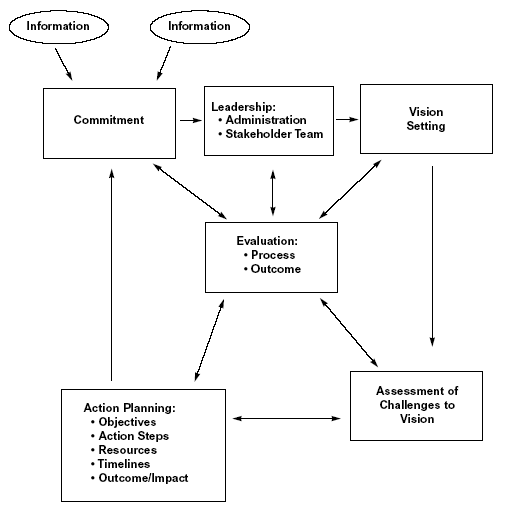Handout 4.6
Leadership Strategies
Collaborative Planning Model for Program Improvement and Systems Change

Collaborative Planning Model For Program Improvement and Systems Change
Barbara J. Smith, Ph.D
University of Colorado at Denver
2003
Our systems change model for program inprovement and systems change is based on what people have told us for over 10 years works for them as well as on the systems change and school reform literature (Smith & Rose, 1993; Smith & Rose, 1994; Hayden, Frederick & Smith, 2003). The steps in the process are described below: Handout 4.6: Leadership Strategies Module 4 The Center on the Social and Emotional Foundations for Early Learning University of Illinois at Urbana-Champaign csefel.uiuc.edu H 4.6 (p.3/3) Rev. 1/03
- Make a commitment and provide leadership: it is important for the administrator to provide leadership by setting a positive tone, establishing a team approach to decision-making and allocating resources; commitment and leadership are facilitated by the kinds of information and personal experiences available to administrators and members of the team.
- Team decision-making: making decisions through a team process comprised of stakeholders (parents, teachers, administrators, community program personnel, etc.) is key to both ownership of the decisions as well as exploring new ideas and strategies; all members of the team must feel equal and that decisions are collaborative.
- Establish a vision: each team must develop a written “vision” of the outcomes they are striving toward. This will guide the work and direction of the team.
- Assess the challenges to the vision: the team’s next step is to identify the challenges to meeting the vision. The challenges may be policy/procedure, resources, knowledge-base, or belief and values.
- Write an Action Plan: once the team has established their vision, they then set measurable goals, objectives, and strategies related to addressing the challenges to the vision, i.e., an “action plan” is written.
- Cultivate leadership and risk taking: administrators should reward and acknowledge those individuals who provide leadership and are willing to take risks for initial experimental efforts.
- Provide technical assistance, fiscal, and other resources: the individuals involved with program improvement efforts may need training, technical assistance, and other supports. Secondly, time and other resources will need to be allocated for collaboration, team meetings, and in-service training.
- Evaluate the change: it is important to evaluate the process and product of the planning effort and to make corrections based on the evaluation data.
References
Hayden, P., Frederick, L., & Smith, B.J. (2003). A Roadmap for Facilitating Collaborative Teams. Longmont, CO: Sopris West.
Smith, B. J. & Rose, D. F. (1994). Preschool Integration: Recommendations for School Administrators. Research Institute for Preschool Mainstreaming. ERIC Reproduction Document # ED 374-627.
Smith, B. J., & Rose, D. F. (1993). The Administrator’s Policy Handbook for Preschool Mainstreaming. Cambridge, MA: Brookline Books, Inc.
We welcome your feedback on this Training Module. Please go to the CSEFEL Web site (http://csefel.uiuc.edu) or call us at (217) 333-4123 to offer suggestions.
About Us | Contact Us | Resources | Chat | Primary Partners & CCTAN | Site Map | Search | Home




